Vampire Survivors is a fast-paced survival videogame where I guide one of several dozen player characters through an ever-growing army of monsters in a variety of dark fantasy environments. I must develop my chosen player character to higher and higher levels of power to keep up with the monster waves, which eventually grow to screen-flooding numbers where a single wrong step can mean death from the weapons, claws, and teeth of hundreds of oncoming horrors. Standing up to these challenges provides frequent yet all-too-brief brushes with overwhelming power and a rush from constant unlocks.
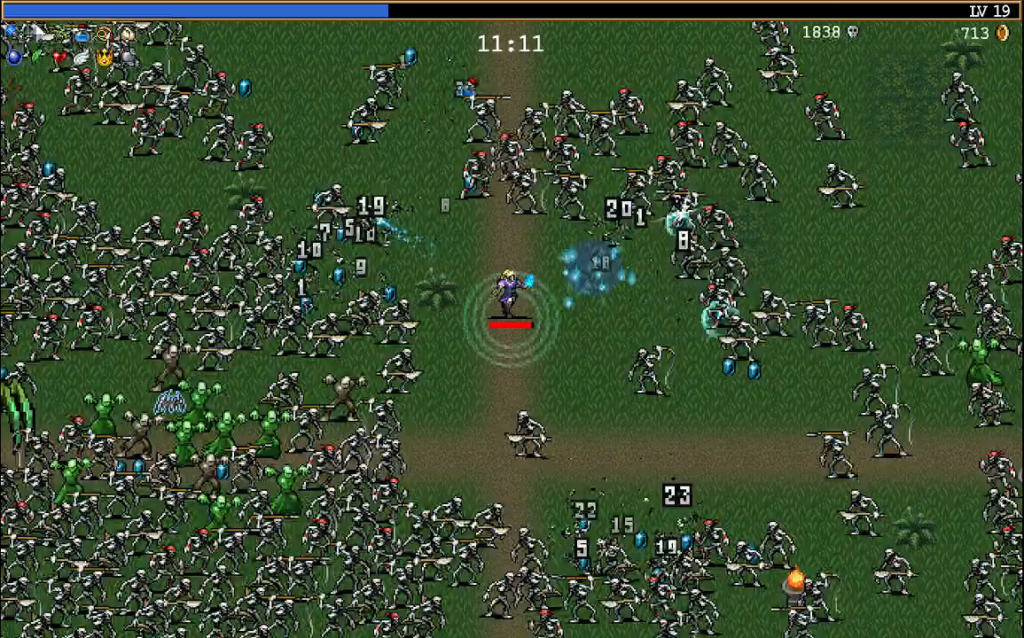
When I think of a survival videogame, it conjures a slow and methodical experience. My player character emerges into a selfish and cruel sandbox and must scrounge for food to sustain, shelter to hide, and a weapon to protect themselves. Beginning with literally sticks and rocks, I work the player character up a tech tree of weapons and tools, developing them from near-helpless prey to apex predator. Often, the player character has only one life to expend in this effort. Vampire Survivors is a survival videogame, sped up a few thousand times.
It accomplishes this by stripping away most of the exploration inherent to the genre and imposing a hard time limit. Instead of monsters being spread out, serving as speed bumps and gate keepers to be dealt with thoughtfully and conservatively, the player character is assaulted by never-ending and ever-expanding monster waves the moment they set foot in a stage. Instead of fashioning sticks and rocks into crude weapons, the player character begins with a useful weapon equipped and can gather many more while killing monsters. Instead of my primary goal being to discover a way to escape or conquer the sandbox across dozens if not hundreds of hours of a single game, I have to survive the sandbox for up to thirty minutes across dozens if not hundreds of different games.
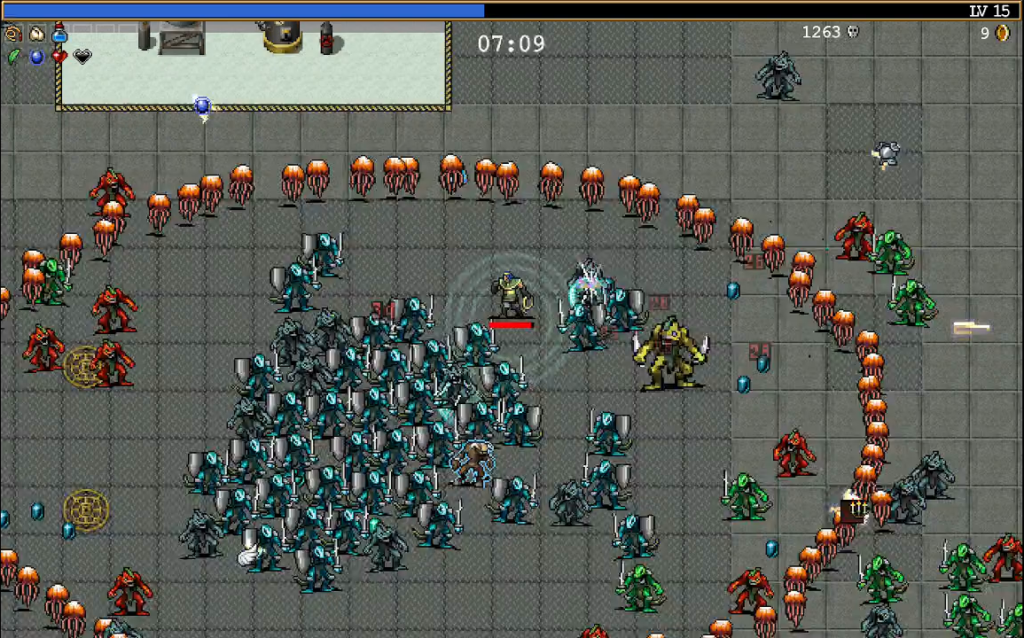
Scale and pace sets Vampire Survivors apart from other survival videogames, but a third and most impactful difference is how I control the player character. There are only two actions to be concerned with: movement and attacking. Movement is controlled by the joystick. Attacking is totally automated, dependent upon which weapons the player character is equipped with. This means the only direct control I have is on movement.
This may sound limiting, but far from it; navigating a gauntlet of enemies, determining which direction the player character goes, how fast they move, and which route they take to get there is more than enough to track. Monster hordes become so overwhelming in a level’s latter half that I’m grateful not to divide my attention between a safe path and effective weapon usage.
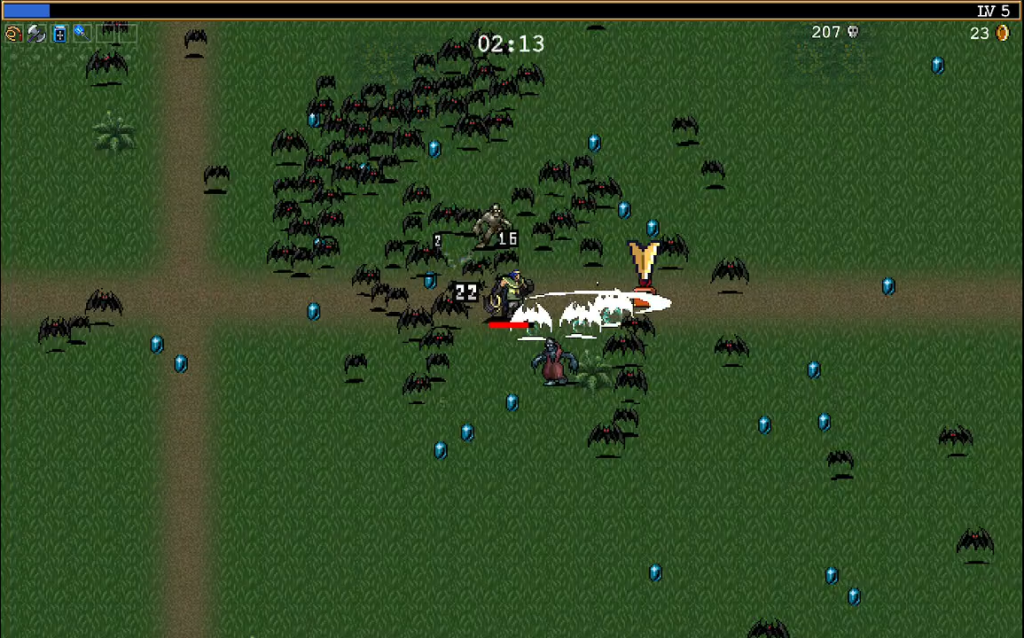
When I first begin Vampire Survivors, I only have one player character unlocked: Antonio Belpaese, a muscular man wielding a whip. When he sets foot in the first stage, the Mad Forest, he is immediately beset by a colony of bats that swoop in from all sides. About once every second, Antonio flings his whip forward automatically. My job is to make sure he’s facing a bat when the whip flies out. Enemies are fragile, at least at first, and go down quickly when the whip makes contact. They leave behind experience gems, which fill up Antonio’s experience meter as he gathers them. Collect enough gems, and Antonio levels up.
Leveling up is the main way to expand the player character’s arsenal of weapons they use in a level. Each character begins equipped with one weapon, but it’s not difficult to add another within seconds of beginning a stage. A whip is effective for killing monsters in front of the player character. A magic wand fires a damaging energy bolt at a nearby monster, no aiming required. A bible circles around the player character for a few seconds every time it activates, damaging monsters it comes into contact with.
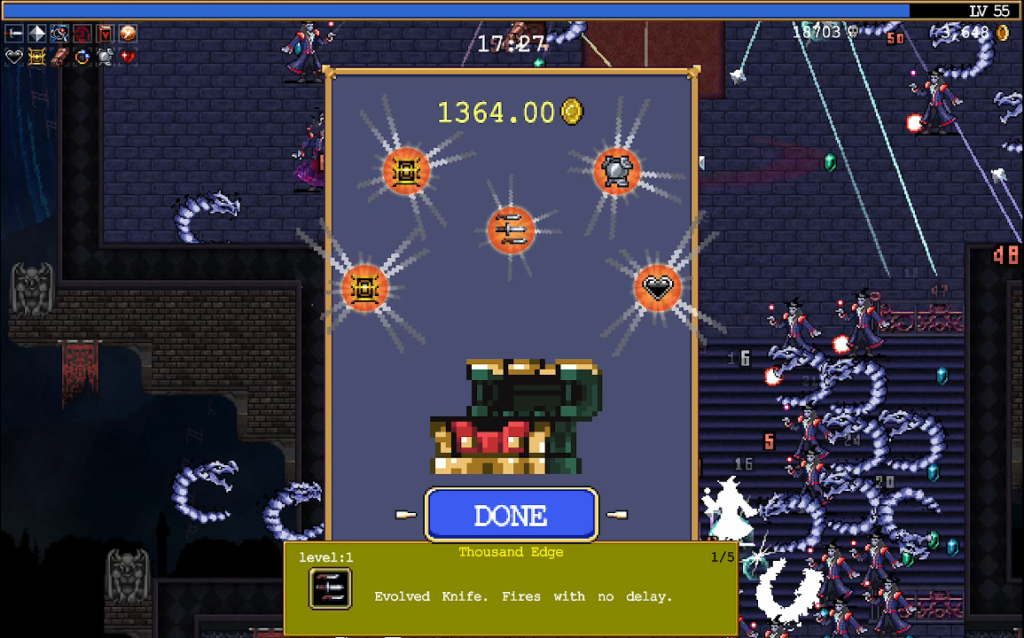
Collecting a variety of weapons is necessary for handling the ever-increasing number of monsters that attack the player character, but their base power becomes less effective as monsters grow stronger. Selecting a weapon the player character already possesses will level it up, increasing its strength and giving it new functions. Leveling up the whip once adds a second whip swing behind the player character with each attack, relieving me from making sure they are facing the right direction when it swings. Leveling up the magic wand increases its power and the rate at which it fires. Level up the bible enough and the player character becomes surrounded by deadly whirling books at almost all times.
And yet even these upgraded weapons become overwhelmed by the sheer onslaught of powerful monsters. The only way to survive in the final ten minutes of a Vampire Survivors level is through the weapon evolution mechanic. Pairing weapons with certain other upgrades available upon level up will cause them to synergize, granting the weapons a new effect. Just one of these weapon evolutions creates a noticeable difference in their death-dealing ability. A well-equipped character, taking advantage of multiple evolutions, can stroll invincibly through an ocean of bloodthirsty monsters. These moments are Vampire Survivors at its best, a heady power trip that puts most other videogames to shame. It’s common to obliterate literally tens of thousands of monsters in a single match.
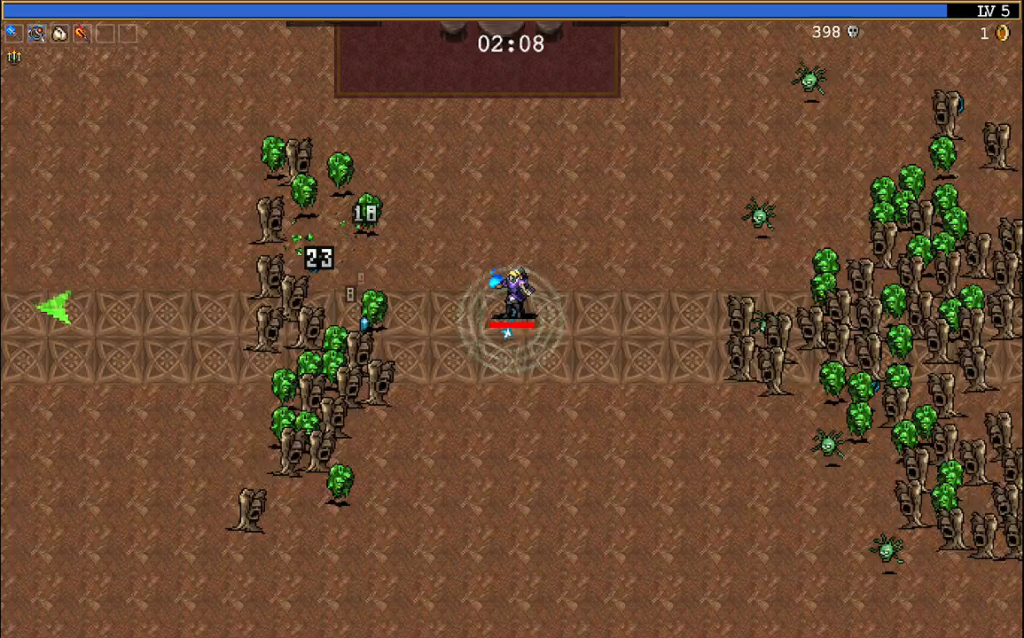
Most of my early hours in Vampire Survivors are spent learning its mechanics. Until I get a good grasp on its fundamentals, it is difficult to survive much past the first ten minutes of the thirty minute limit. After a few hours, I learn which weapons work best—and there are definitely some that are heroes and others that are comparative stinkers—and I am able to consistently survive all thirty minutes of the monster gauntlet.
Yet there’s more to each stage than it first appears. The Mad Forest creates a misleading first impression, its simple design and repetitive tile graphics making me feel like the player character wanders an infinitely circling void that contains only monsters. The second level, the Inlaid Library, introduces something new to the interface: a bright green arrow on the edge of my screen. Following this arrow leads to the first relic, the Grim Grimoire, which logs the weapon evolutions as I discover them. I can consult this log at any time in the pause menu, reminding me of which weapons needs to be paired with which upgrades. Other levels hide more relics which guide me towards Vampire Survivor’s many other secrets.
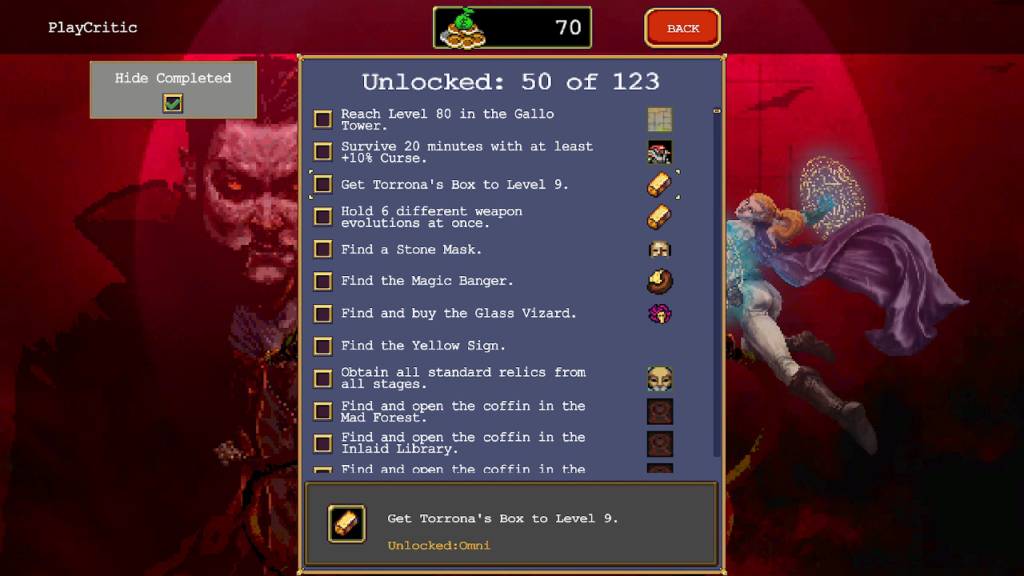
Before I’ve done anything else in Vampire Survivors, I can see two options on the main menu that excite me: Collection and Unlocks. The Collection screen shows every weapon and item I’ve found. The Unlocks screen shows what goals I need to meet to earn the vast armory of weapons and items, in addition to many other rewards. It’s these many, many unlocks that keep me coming back to Vampire Survivors even after I have mastered its fundamentals and becoming a whirling death dervish becomes wearyingly easy.
Meeting an Unlocks goal begins simply enough, ranging from reaching level 5 to surviving for one minute in a single stage. When I’m first learning how to play, it’s not unusual to meet multiple goals even in a short game where my player character falls to the horde after only a few minutes. If the sound effect that accompanies a trophy or achievement unlocking sends a joyful buzz reverberating through your chest cavity, Vampire Survivors will provide you with many of these Pavlovian rewards multiple times an hour. The number of these goals is deceptively colossal, with the list expanding and compounding itself the more I check off the list.
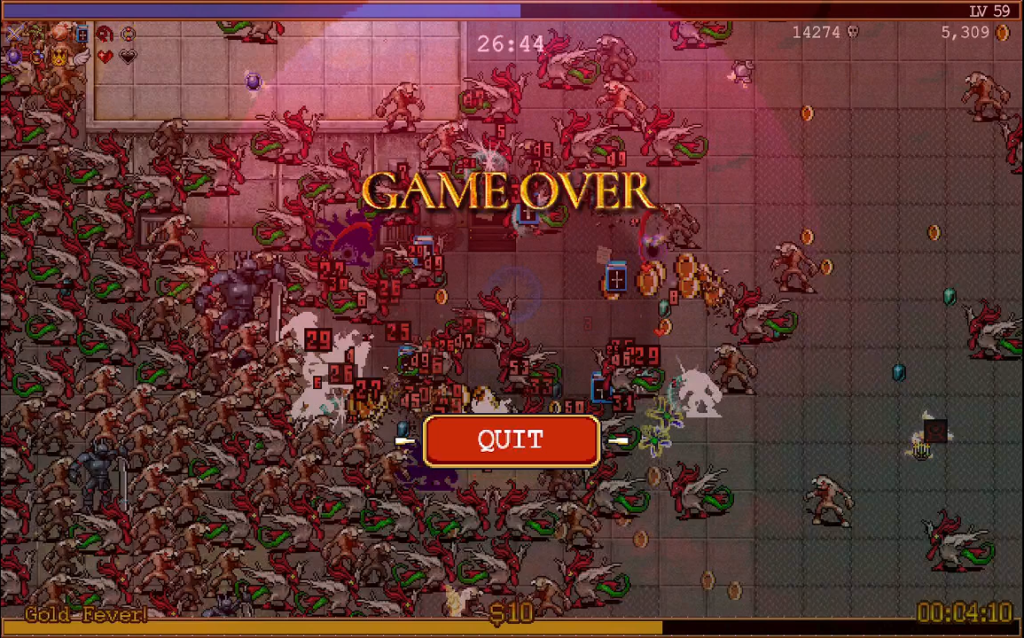
Yet after a few more hours of constant unlocks and achievement notifications, even this part of Vampire Survivors begins to lose my interest. Despite the dozens of player characters, the many levels where I may play as them, the variety of spooks, specters, vampires, and villains to bulldoze through, and the quantity and variety of unlocks to keep me coming back, my every game becomes the same: Pick synergizing weapons and become a whirlwind of walking death for up to thirty minutes.
I don’t know if Vampire Survivors has a proper ending, but after uncovering a mysterious sign that lets my player character challenge a grim reaper-like enemy at the end of a certain level’s thirty minute countdown, I unlock an achievement called “Game Killer.” Feeling this is satisfactorily climactic, I decide I am finished. Despite many more unlocks remaining on my list, I feel little desire to return and check off more. I know it will feel much the same as it has for the past several hours. Though I unlock new characters and tools, the experience remains mostly the same.
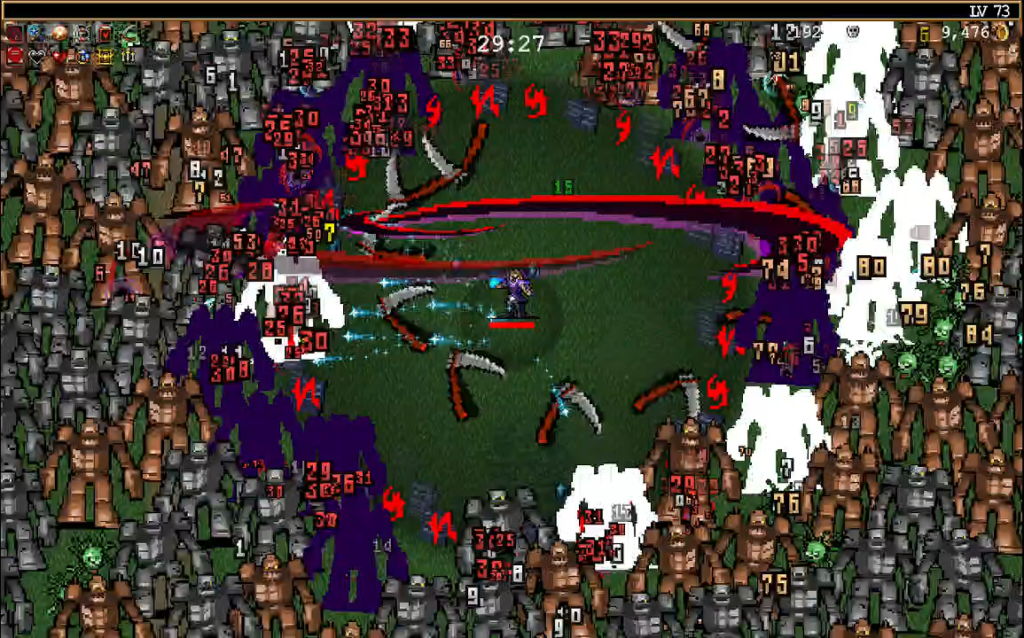
Vampire Survivors is a creative, unique, and even fun videogame that taught me a valuable lesson I hadn’t known before: Power effortlessly wielded doesn’t hold my interest even if there is some thought and practice needed to achieve it. My best time with it is during the opening hours when I have no idea what I am doing, failure is constant, and unlocks are plentiful. Once I learn its fundamentals, each run becomes a thirty minute wait until the next unlock. It’s not totally dull, but I find my desire to wait thirty minutes between goals lessening with each one earned until I simply stop. Vampire Survivors is great fun to learn, but once I know what I am doing my interest wanes long before I finish its cavernous list of unlocks.